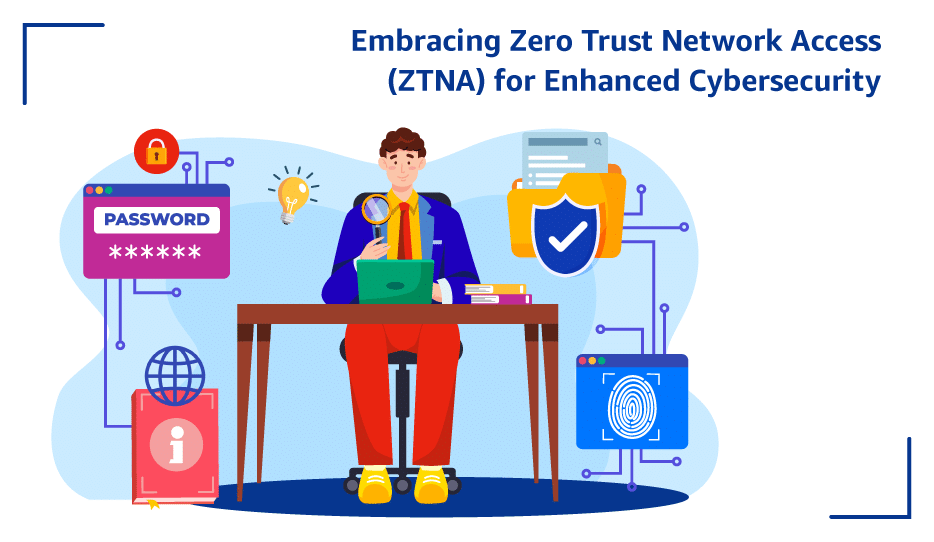
In an era where cyber threats are becoming increasingly sophisticated, and remote work has become the norm, traditional network security measures are no longer sufficient to protect an organization’s sensitive data. Enter Zero Trust Network Access (ZTNA), a paradigm-shifting approach to cybersecurity that is gaining prominence in the business world. This article explores very crisply the concept of ZTNA, its benefits, implementation strategies, and its relevance for modern cybersecurity.
What is ZTNA?
Zero Trust Network Access (ZTNA) is a cybersecurity framework that operates on the principle of “never trust, always verify.” In essence, it assumes that no entity, whether inside or outside the corporate network, should be trusted by default.
Instead, ZTNA enforces strict identity verification and access controls for every user, device, and application attempting to connect to the network, regardless of their location.
Key components of ZTNA
Identity-centric security
ZTNA focuses on authenticating and authorizing users and devices based on their identity. This process includes multifactor authentication, biometrics, and continuous monitoring to ensure that access is granted only to authorized personnel.
What is identity?
In the context of ZTNA, identity refers to the digital representation of a user, device, application, or entity attempting to access network resources.
Micro-segmentation
ZTNA divides the network into micro-segments, effectively compartmentalizing critical assets and limiting lateral movement within the network, once access is granted. This approach minimizes the potential attack surface and enhances cyber security.
Secure Access Service Edge (SASE)
ZTNA often integrates with the SASE framework, providing cloud-native security services at the network’s edge. This enables secure access from anywhere, without the need for traditional VPNs.
What is a network edge?
Network edge refers to the boundary or perimeter of a network where data enters or exits. It’s the point at which a local network, typically within an organization or a specific location, connects to external networks, such as the internet or other remote networks.
Benefits of implementing ZTNA
Improved Security Posture: ZTNA eliminates the trust placed in a network’s boundary-defined security, reducing the risk of unauthorized access and lateral movement of threats within the network.
Enhanced User Experience: Users can access resources securely from any location, improving productivity and flexibility.
Reduced Attack Surface: By implementing micro-segmentation and strict access controls, Zero Trust Network Access reduces the exposure of critical assets to potential attackers.
Compliance and Regulatory Alignment: ZTNA assists organizations in meeting compliance requirements by enforcing strict access policies and providing detailed audit trails. It allows businesses to demonstrate their dedication towards data protection and integrity.
Implementing ZTNA
While the implementation of Zero Trust Access Network is a huge discussion in itself, we will briefly cover the phases of implementing ZTNA.
Inventory and Asset Mapping
Start by identifying all network assets and mapping them to their respective roles and permissions.
Identity and Access Management (IAM)
Implement robust IAM systems that include strong authentication, authorization, and continuous monitoring.
Segmentation
Divide the network into micro-segments based on asset criticality and user roles. Ensure that communication between segments is strictly controlled.
Zero Trust policies
Develop and enforce Zero Trust policies that govern user and device access to resources. Regularly review and update these policies.
Continuous monitoring
Implement real-time monitoring and anomaly detection to identify potential threats promptly.
User education
Train employees on ZTNA principles and best practices for secure access.
Use cases of ZTNA for your business
Authentication and Access
Zero Trust Network Access (ZTNA) serves as a revolutionary approach to enhancing access control and security within organizations. Unlike traditional IP-based VPNs, which grant extensive network access once authorized, ZTNA takes a far more sophisticated approach. It offers highly granular access to specific applications and resources, all based on a user’s identity.
This level of precision ensures that only authorized personnel gain entry, drastically reducing the risk of unauthorized access. Moreover, ZTNA empowers organizations to implement location- or device-specific access control policies, effectively preventing unwanted or compromised devices from compromising the organization’s valuable resources.
This stark contrast is particularly evident when comparing ZTNA to VPNs, which often extend the same access privileges to employee-owned devices as they do to on-premises administrators.
Holistic Control and Visibility
While ZTNA excels in providing robust authentication and access control, it is important to acknowledge its limitations. Once authenticated, ZTNA does not scrutinize user traffic, potentially leaving organizations vulnerable to malicious activities by authorized users or in the event of lost or stolen credentials.
To address this concern, organizations can integrate ZTNA into a secure access service edge (SASE) solution. This strategic combination not only fortifies remote access security but also offers scalability and network capabilities essential for modern organizations.
Furthermore, the integration enables post-connection monitoring, a vital safeguard against data loss, malicious actions, or compromised user credentials.
This holistic approach ensures that organizations remain vigilant and protected throughout the entire access process.
Rely on Logix’s network security experience
In the face of evolving cyber threats and the increasing demand for remote work, Zero Trust Network Access emerges as a crucial component of modern cybersecurity. Its emphasis on identity-centric security, micro-segmentation, and strict access controls makes it a powerful defence mechanism against today’s sophisticated attacks.
As the adage goes, “trust but verify”. Logix, with its 24+ years in the cyber security industry, heavily advocates and implements this mantra through its cyber security and network security offerings, making it a foundational strategy for secure business operations in the digital age.